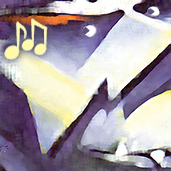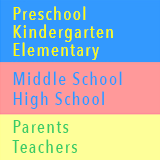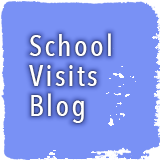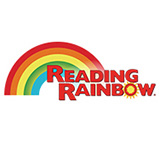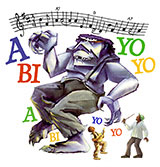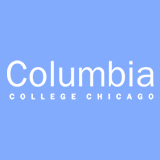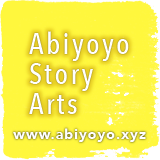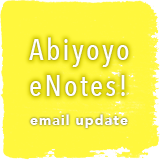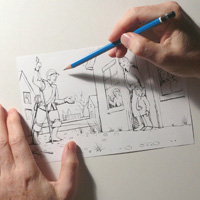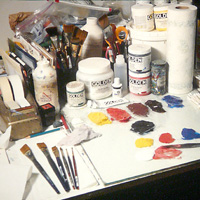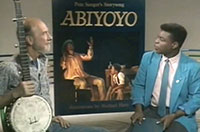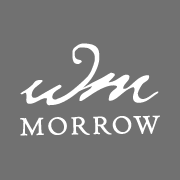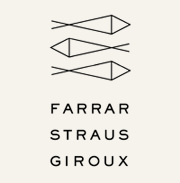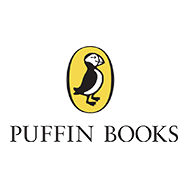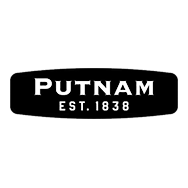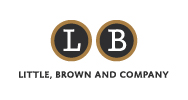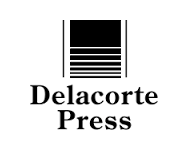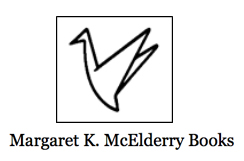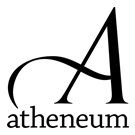K-12 story arts literacy program - Retirement Communities too!
My Abiyoyo Story Arts presentation includes storytelling, singing and a visual explanation of my illustration process. My “take away” message is that an illustrator, like a writer, works from rough notes (sketches) through outlines (storyboards) and revisions to arrive at a final draft (published art). I point out that sketching scenes from a story can help a young writer organize the plot of their story and help their writing come more easily.
I enjoy presenting to kindergarten, elementary, middle school and high school students. You may want to schedule separate programs for each age group so I can tailor my tone and vocabulary more precisely. I do pace my program with a lively blend of elements. By alternating between explaining the art process and performing stories, I can hold the attention of the youngest audiences for an extended period. If the younger kids' attention starts to drift while I explain the art process, they immediately refocus as we begin another reading/performance. So, I am OK with presenting to K-12 all together in one assembly group if this works best for you.
Here are the books we explore:
Some Friends to Feed, The Story of Stone Soup
I start by showing step-by-step examples of this book's art process. I show students how sketches lead to drawings, to photos, color sketches, and finally to finished full color art. Then we experience the published book. I display the finished art on screen one page at a time as I tell the story and sing the song which weaves through the narrative. More info about this book.
W is for Windy City, A Chicago Alphabet
I show step-by-step examples of the art process for W is for Windy City, A Chicago Alphabet. We review my search for images of the people and places important to Chicago. This book's process features how an illustrator today makes use of digital media like Photoshop to plan out illustrations and work more efficiently. Students see a few time lapse sequences of my painting process. I perform the book's alphabet poems while we review the published book on the screen. More info about this book.
Pete Seeger’s Storysong Abiyoyo
Before I show any Abiyoyo artwork, I tell the story by acting out the characters in dramatic fashion: the boy, the father and the giant Abiyoyo threatening, than dancing and singing. Then I show this book's art process step-by-step. We see how the giant Abiyoyo’s illustrated character evolved through several very different versions. I conclude showing the final full color Abiyoyo art as I summarize my take away message: A book illustrator works through many stages of revision before producing finished art. I tell students that this same process of rough drafts and multiple revisions is essential for writers too. More info about this book.
Kindergarten and lower elementary students
With the youngest audience I am storytelling, singing and explaining, in simple terms, how an artist makes a book. “A big beautiful full color illustration in a picture book begins with an artist making a little scribbly pencil sketch." I rely more on images to get across the main idea–that an artist redraws the same scene over and over again to make a better finished illustration. The highlight for this audience is performing stories and songs–especially Abiyoyo. The sequence of Abiyoyo sketches is particularly entertaining. And when I call on everyone to sing together, K-2 students join in!
Upper elementary students
With this group I explain my art process in more detail and my vocabulary can stretch a bit. "A book illustrator doesn't make a beautiful color painting all at once. I start with small "thumbnail" sketches, then make bigger rough pencil drawings, I research photos on the web and use this visual reference to help me add details to my drawings. I ask kids and grown-ups to put on costumes and pose for staged photos. I trace these photos or composite them in a digital Photoshop file. I print a mock-up in book form using these drawings and send it to the publisher for review. I create miniature color sketch to plan out my color pallette. Only then do I produce the final, full color, full sized paintings. A commercial illustrator works as part of a creative team with publisher and author."
With this age group the Q and A session at the end of the program is lively. The students ask about my painting technique, how long the art process takes or how much an illustrator gets paid! They want to know answers. We often end these sessions with an art assignment: Draw your own version of the scary giant Abiyoyo. You can see samples of student art on my Abiyoyo Story Arts web site here.
Middle school students
Middle school students enjoy my story performance just as much, but our discussion of the commercial art process goes more in-depth. I talk about how an illustrator interacts with the editor at the publishing house. I emphasize the importance of responding constructively to criticism, finding creative solutions that please the publisher as well as the artist, and using technology to work more efficiently. We talk about how digital media is changing the world of illustrating and publishing. I encourage middle school students to begin thinking about their own careers. I show middle and high school students samples of the many YA jackets I have illustrated.
High school students
I discuss Pete Seeger's life with high school students and Pete's ideas about the scary giant Abiyoyo and what he might represent. I talk to high school students about the importance of producing a body of work: writing stories or making art or doing both in muti-media mash-ups. It is never too early to start. Collecting even very short stories and simple sketches in a portfolio or on a web blog is the next step to becoming a professional. We can point them to web sites of professional illustrators they can review. I suggest they get familiar with professional associations like Society of Children's Book Writers and Illustrators. I ask them to condsider someday attending the college where I teach, Columbia College Chicago.
Introduce children to the songs and stories of Pete Seeger!
It's a treat for me to introduce young students to Pete Seeger and to sing them Pete's song "If I Had a Hammer." Students see a dramatic performance of his storysong Abiyoyo! I reveal how Pete art directed my work through many stages as we created the Abiyoyo picturebook character. I point students to my Abiyoyo Story Arts web site, filled with background information about Pete Seeger's life, work and our storysong Abiyoyo here.
Organize a book sale and signing.
We can arrange a book sale and signing if we work a month ahead of my appearance at your school. I prepare custom book order forms for your school. You collect book order totals and payments. I order the books and bring them to your school. It's a little more work, but the kids end up with signed copies they can have in their book collection.
Contact me to schedule a school presentation.
I have appeared at many schools and libraries in the Chicago area, where I have lived and worked since 1988. If your school or library is in another part of the country and want to book an appearance, contact me. With the right schedule and budget we can make it happen.
email mh@michaelhays.com
Need more info?
If you'd like additional information about my education and professional experience–
Download my Vita.
